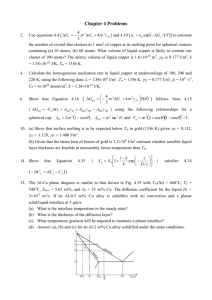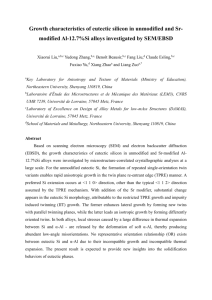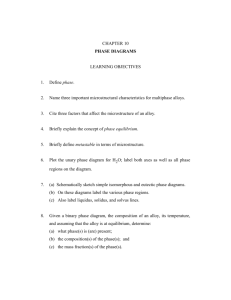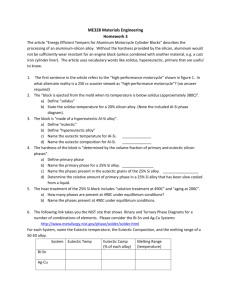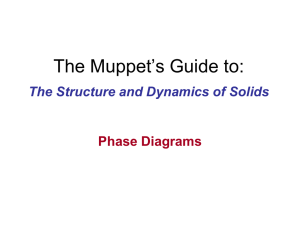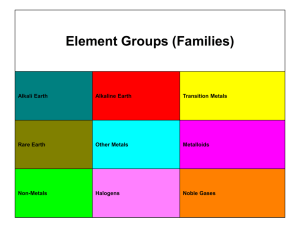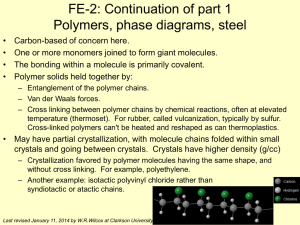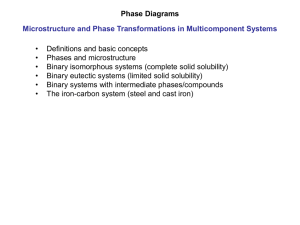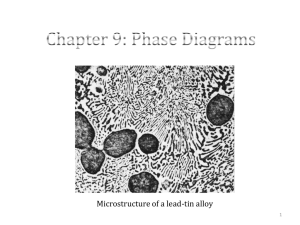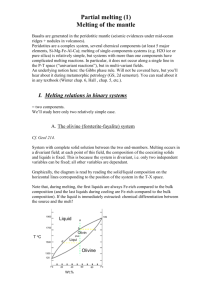Phase Diagrams: Materials Science Presentation
advertisement
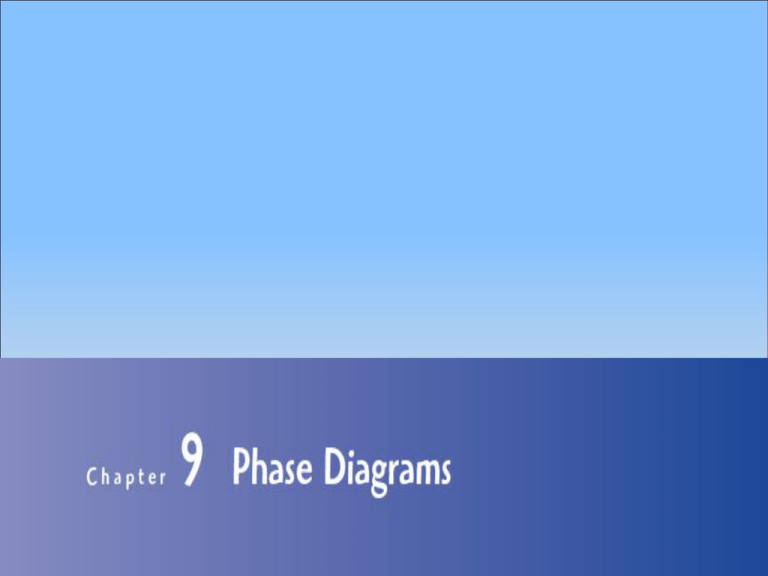
1 Introduction Phase Diagrams are road maps Chapter 09: Phase Diagram 2 Component: Pure metals/compounds of which an alloy is composed System: Alloy system, e.g., Iron-Carbon alloy system, copper-nickel alloy system Solid solutions - Substitutional - Interstitial Chapter 09: Phase Diagram 3 Solubility Limit: Max concentration of solute atoms that may dissolve in the solvent to form a solid solution. Phases: Homogenous portion of a system that has uniform physical and chemical properties Chapter 09: Phase Diagram 4 Source: William Callister 7th edition, chapter 09, page 254, figure 9.1 Chapter 09: Phase Diagram 5 Each phase has different phase physical properties Microstructure •Characterized by number of phases, proportions and the manner of distribution of phases. •Depends on: Alloying elements, concentrations, heat treatment (temp, heating/cooling rate etc.) Chapter 09: Phase Diagram 6 Phase equilibria Free energy Equilibrium Phase equilibrium Non-equilibrium state: State of equilibrium is never reached since the rate of approach to equilibrium is very slow. Chapter 09: Phase Diagram 7 Equilibrium phase diagram •Represents the relationships between temperature and compositions, and the quantities of phases in equilibrium •Binary Alloy: two components Chapter 09: Phase Diagram 8 Binary Isomorphous Systems Chapter 09: Phase Diagram Source: William Callister 7th edition, chapter 09, page 259, figure 9.3 a&b 9 Isomorphous: Complete solubility in both liquid and solid states Three kinds of info: •Phases, •compositions, •percentages/fractions of phases Chapter 09: Phase Diagram 10 At 1250°C and Co=35% Ni Where, WL: weight fraction of liquid WL 4335 0.73 73% 4332 W 3532 0.27 27% 4332 Chapter 09: Phase Diagram 11 Inverse lever rule 1.Draw tie-line across the two phase region 2.Locate the overall composition (e.g., Co=35%Ni) 3.To compute the fraction of one phase, take the length of the tie-line from the overall composition to the opposite phase boundary and divide by the total tie line length 4.Repeat above procedure for the other phase. Chapter 09: Phase Diagram 12 ------------------ (1) ------------------ (2) Where, Cs and C both are same Chapter 09: Phase Diagram 13 Development of microstructures Source: William Callister 7th edition, chapter 09, page 265, figure 9.4 Chapter 09: Phase Diagram 14 Development of microstructures continue… Source: William Callister 7th edition, chapter 09, page 267, figure 9.5 Chapter 09: Phase Diagram 15 Development of Microstructures The compositions readjust with changes in temperature. These changes occur through the process of diffusion. Because diffusion is time-dependent, much more time is required, at each temperature for compositional adjustments. Diffusion rates decrease with temperature. In reality, cooling rates are so fast that there is little time to enable equilibrium cooling. Chapter 09: Phase Diagram 16 Non-Equilibrium Solidification •Because of fast cooling, there is a non-uniform distribution of the two elements for isomorphous alloys “Segregation” In the centre of each grain, the high melting element solidifies first. At the periphery, the low melting element solidifies. Chapter 09: Phase Diagram 17 Coring Cored Structure: Concentration contours •Undesirable less than optimal properties due to inhomogeneity. •Coring is eliminated by a homogenization treatment. At a temperature below the solidus point for the composition; atomic diffusion causes homogenization. Chapter 09: Phase Diagram 18 Mechanical Properties of Isomorphous Alloys Source: William Callister 7th edition, chapter 09, page 268, figure 9.6 Chapter 09: Phase Diagram 19 Mechanical Properties of Isomorphous Alloys •Solid solution hardening or an increase in strength and hardness by the addition of the other component •At an intermediate composition, the curve (TS Vs Comp) passes through a maximum Chapter 09: Phase Diagram 20 Binary eutectic systems Source: William Callister 7th edition, chapter 09, page 269, figure 9.7 Chapter 09: Phase Diagram 21 Binary eutectic systems Continue ….. :Solid Solution of Ag in Cu-Rich solvent :Solid solution of Cu in Ag-Rich solvent Technically, : Pure Cu : Pure Ag Below BEG, only limited solid solubility takes place Chapter 09: Phase Diagram 22 Binary eutectic systems Continue ….. CEA: (solid) solubility limit for Ag in – phase (Cu-Rich) HGF: Solubility limit for Cu in -phase (Ag-Rich) CBA is between /(+) and /(+L) phase regions •Max. at 7.9% Ag (780°C) •Decrease to zero at 1085°C (Melting point of pure Cu) Chapter 09: Phase Diagram 23 Binary eutectic systems Continue ….. For –phase CB: solvus line: /(+) AB: Solidus line: /(+L) Chapter 09: Phase Diagram 24 Binary eutectic systems Continue ….. Prepare similar notes for -phase region HGF is between For -phase HG: Solvus line and GF: Solidus line Chapter 09: Phase Diagram 25 Binary eutectic systems Continue ….. Three two-phase regions: +L, +L and + E: Eutectic invariant point CE: 71.9 wt% Ag Cu-Ag system: TE: 780°C Chapter 09: Phase Diagram 26 Binary Eutectic systems Continue ….. Eutectic Reaction: Liquid Solid 1 + Solid 2 At E, L L(CE) Chapter 09: Phase Diagram + (C E) + (C E) 27 Binary Eutectic systems Continue ….. For Cu-Ag system, L(71.9 wt% Ag) Chapter 09: Phase Diagram (7.9 wt% Ag) + (91.2 wt% Ag) 28 Binary Eutectic systems Continue ….. Solidus line at 780°C: Eutectic isotherm Phase volume fractions represent proportions seen in the microstructure; so they can be estimated from microstructures, and the mechanical properties can be estimated as well . Chapter 09: Phase Diagram 29 Binary Eutectic systems Continue ….. Source: William Callister 7th edition, chapter 09, page 271, figure 9.8 Chapter 09: Phase Diagram 30 Problem: For Pb-Sn system at 150°C, calculate relative amounts of each phase by (a) Mass fraction (b) Volume fraction Given : ρ α :11.2 gm/cm 3 ρ β :7.3 gm/cm 3 (a)Solutio n C β C 1 Wα 99 40 0.67 C β C α 99 11 Chapter 09: Phase Diagram 31 Problem: Continue …. C1 C α 4011 0.33 Wβ C β C α 9911 1-0.67=0.33 (b) Solution Volume Fraction 67 gm 5.98cm3 v ( ) 11.2 gm/cm3 33 gm 3 v 4.52cm ( ) 7.3 gm/cm3 Chapter 09: Phase Diagram 32 Problem: Continue …. Volume Fraction vα Vα 5.98 0.57 v α v β 5.98 4.52 vβ Vβ 4.52 0.43 v α v β 5.98 4.52 Chapter 09: Phase Diagram 33

